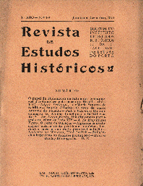

................................
The main objectives of this publication were to promote an objective and scholarly discussion, led and headed by academics, of facts of general history that had never been questioned before, as well as to develop historiographical production linked to the city of Porto. Bringing together articles, many of them unpublished, on topics such as history, Portuguese and foreign literature, numismatics, archaeology and anthropology, the main editors of this publication were lecturers at the Faculdade de Letras do Porto [School of Arts and Humanities of Porto], although there were occasional contributions from figures outside the institution. The most prolific contributor to this journal was its editor, Damião Peres, author of nine articles out of a total of twenty-eight. However, other professors from the institution also made notable contributions, such as António Mendes Correia, Pedro Vitorino, Artur de Magalhães Basto, José Teixeira Rego and Angelo Ribeiro. Among contributors from outside the institution, the work of Edgar Prestage, an English historian and the only foreign contributor to this publication, professor of Camões at the University of London, Paulo Merêa, Ludovico de Menezes and the specialist in Hebrew Studies, Artur de Barros Basto, is noteworthy.
The main topics covered by the authors are the history of Portugal, the history of Porto, the history of art in Porto, archaeology and anthropology, and German and Portuguese literature. With regard to the history of Portugal, there are articles on the island of Madeira, diplomatic history, particularly in the post-Restoration period, the history of literature, the publication of historical sources and the study of influential figures from our past. There is a strong presence in this publication of various articles on the history of Porto, written by several authors, showing the city as the stage for major events, such as the invasion by Junot’s troops and the funeral of Dom Pedro II. The city of Porto is also presented as the heir to artistic treasures, evident in its Municipal Museum, which is constantly studied in this publication.
This work is financed by national funds through FCT - Foundation for Science and Technology, I.P, in the scope of the projects UIDB/04311/2020 and UIDP/04311/2020.
